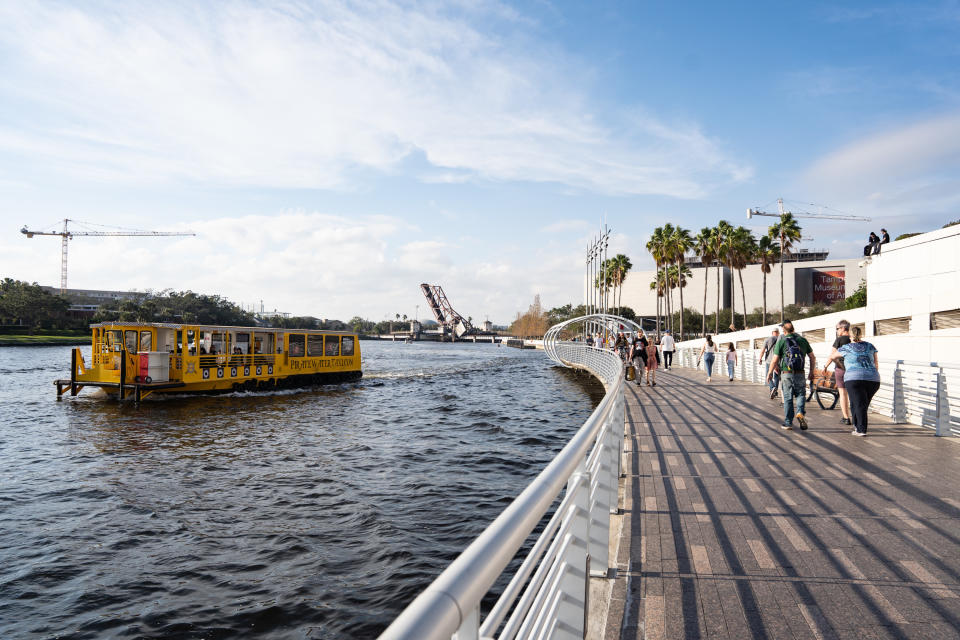Here are the latest details on Tampa’s Riverwalk expansion plans
TAMPA — Each day, runners and walkers, tourists and locals pour onto the Riverwalk, the 2.6-mile ribbon of sidewalk that runs along Tampa’s downtown waterfront. In a few years’ time, city officials want crowds to be able to trot along the west bank of the Hillsborough River, too.
The cost of making that vision a reality has ballooned in recent years.
Prepandemic, city staff estimated an approximately 6-mile pedestrian- and bike-friendly path weaving through a swath of land on the west bank of the Hillsborough River, dubbed West Riverwalk, would cost $30 million.
On Thursday, the Tampa City Council voted 5-2 to amend the proposed construction agreement to $56.8 million. The contract will require a final vote, which is scheduled for July 18.
If approved, as appears likely, the project is expected to break ground in the next few months and to be completed in 2027, city records show.
The federal government has agreed to chip in $24 million. The city is on the hook for the rest.
About 2 miles of the planned route will hug the waterline, from Platt Street near the Bayshore Publix in Hyde Park north to an area near Rick’s on the River restaurant, paralleling the original version on the east bank.
Given the Tampa Bay region’s deadly track record for pedestrians and cyclists, city officials say the project will emphasize safety. Bike paths will be separated from car traffic by concrete curbing wherever possible — part of a city system called “the green spine.”
It will include walker-activated flashing pedestrian crossings, among other enhancements. Plus, there’ll be over-the-water crossings that run underneath car-traffic bridges at Platt and Brorein streets.
The project will ultimately complete a network of 12 miles of continuous bike and pedestrian pathway unspooled across Tampa’s urban core.
“Tampa’s Riverwalk in just a few years has become such a signature part of the community, it’s hard to imagine Tampa without it,” Mayor Jane Castor previously told the Tampa Bay Times. “The project on the west side will be even more transformative.”
While council members appeared united in their recognition of the project’s perks, the price tag was a hard sell, especially as the city has streets riddled with potholes and has 1,300 miles of sidewalk gaps.
“How can we justify to the public that we are not fixing their roads?” council member Bill Carlson said at Thursday’s meeting.
“As much as I want this — and I am the first person to support mobility — we cannot afford it,” council member Lynn Hurtak said.
She and Carlson were the two votes against the $56.8 million design and construction agreement between the city and firm The Haskell Co.
“If we say no to this, we’re giving away $24 million,” said council member Luis Viera, not wanting the city to turn down the federal grant and among the majority who voted in favor of the agreement. “Then that money is gone.”
The grant from the U.S. Department of Transportation, secured by U.S. Rep. Kathy Castor, D-Tampa, was supposed to cover 80% of the project, according to initial projections.
Costs have since soared. The grant now covers 40%. The city plans to pay for the rest by using $6 million from the Community Investment Tax and taking on more than $26.8 million in debt, city documents show.
Vik Bhide, the city’s mobility director, told council members Thursday that his team continues to search for opportunities to secure additional state and federal funding for the project “to make sure that the burden on the city is as low as possible.”
The cost increases are “consistent with every other agency that does large-scale infrastructure projects in the Tampa Bay area and within the state of Florida,” he told council members.
“We have a lot of needs. We have paving needs. We have sidewalk needs. Those needs are critical and must be addressed,” he said. “We’re also a rapidly growing city and we have to consider investments as well.”


